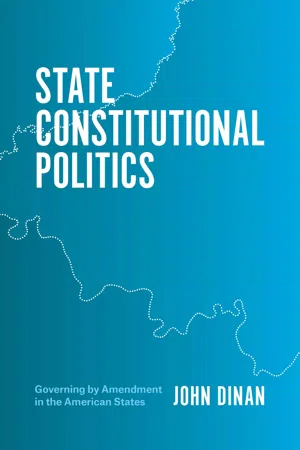![]()
PART I
Amendments
![]()
CHAPTER ONE
State Constitutional Amendment Processes and Practices
To explain why state constitutional amendments play a prominent role in state politics and governance, I first turn to the design of state amendment processes. These processes have not always been as flexible as they are in the twenty-first century; they only gradually became more flexible over time. Nor are the amendment processes equally accessible in all states. Yet they are in nearly all respects more accessible than the federal process.
Due in part to the accessibility of state amendment processes, along with a willingness of citizens and public officials to make use of them, state constitutions are amended frequently. States vary in how frequently their constitutions are amended. Some state constitutions are amended once every few years, whereas in other states amendments are adopted several times each year. But every state constitution is amended more frequently than the US Constitution.
State Constitutional Amendment Processes
In contrast with the US Constitution, which can only be amended by a two-thirds vote in Congress or a convention called after a petition from two-thirds of the states, followed by ratification in three-fourths of the states, the fifty state constitutions can be amended in ways that render them more flexible. Every state constitution allows the legislature to generate amendments. It is also understood in every state that the legislature can call a convention with the power to undertake a wholesale constitutional revision or submit amendments in piecemeal fashion to voters for ratification. Conventions can also be called in fourteen states through referenda that appear on the ballot automatically at regular intervals. Eighteen states provide for citizen-initiated amendments in which voters place amendments on the ballot and approve them, generally without a role for the legislature. In a number of states, commissions have been established with the power to recommend amendments for the consideration of legislators or conventions; in one state, commissions can even submit amendments directly to voters for ratification.
Legislature-Generated Amendments
Although all states currently allow legislatures to generate amendments, this device only took its current form after wide-ranging experimentation in the late 1700s and early 1800s. Even today, rules for enacting legislature-generated amendments vary significantly, with some states setting low barriers to legislative approval and voter ratification and other states setting somewhat higher thresholds.
The inaugural Delaware and Maryland constitutions, drafted by conventions held in the summer and fall of 1776, midway through an initial wave of constitution making in 1776–77, were the first state constitutions to make explicit provision for legislature-generated amendments.1 Constitutions framed earlier in 1776 either failed to make explicit provision for amendments, as in New Hampshire, South Carolina, Virginia, and New Jersey, or permitted a council of censors to recommend amendments for approval by a convention, as in Pennsylvania.2 Delaware’s constitution, adopted in September 1776, was the first to set out an explicit process for legislature-generated amendments. Delaware relied on a supermajority vote requirement to distinguish between the process for amending the constitution and the process for passing a statute, by providing that amendments could be adopted with the support of five-sevenths of the members of the lower house and seven of the nine members of the upper house.3 The Maryland constitution that took effect two months later followed a different approach. The legislature had to approve an amendment and publish it at least three months prior to an election; then the newly elected legislature had to approve the amendment a second time before it could take effect.4 In designing amendment procedures over the next several decades, state constitution makers generally combined these two states’ approaches, by requiring amendments to be approved by a legislative supermajority in two sessions separated by an intervening election.5
Connecticut’s 1818 constitution was the first constitution to require legislature-crafted amendments to be submitted for voter ratification.6 In earlier years, constitution makers had sought to gauge public support for amendments in an indirect fashion. By requiring the legislature to approve amendments both before and after an intervening election, voters could register their displeasure and prevent final passage of an amendment by unseating legislators in the election. Constitution makers in Connecticut sought to obtain a more direct expression of public support. In what could be called a belt-and-suspenders approach, Connecticut’s constitution required legislative approval by a majority of the lower house in one session, then reapproval, after an intervening election, by a two-thirds majority of both houses, followed by ratification by a majority of voters.7 Drafters of Maine’s 1820 constitution dispensed with the indirect test of popular support in an intervening election. They simply provided for legislative approval of amendments by a two-thirds majority in both houses, followed by ratification by a majority of voters.8
In designing legislature-generated amendment processes during the nineteenth century, framers of state constitutions generally followed Connecticut’s approach, especially prior to the 1850s, or Maine’s approach, especially after the 1850s.9 Most states drafting or revising constitutions during the remainder of the nineteenth century required amendments to be approved by the legislature—generally by a supermajority vote and usually in consecutive sessions but occasionally in a single session—and ratified by voters.
In all fifty states the legislature can craft amendments; but states maintain a range of requirements for legislative approval, as shown in table 1.1 where states are arrayed according to the flexibility of their current legislative-approval rules.10
Table 1.1 Legislative-approval requirements for legislature-generated amendments
| Two-thirds legislative approval in at least one house and approval in two sessions (4 states)* |
| Delaware | Tennessee |
| South Carolina | Vermont |
| Two... |
